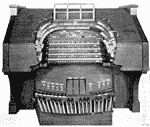 |
||
Ballroom Organ
It was the intention of Mr. Lincoln Dickey, the first manager of the Hall, to use this room as a dance hall and also as a motion picture theatre. Therefore, he wanted an organ of the orchestral type (or as he viewed it, a theater organ). Senator Richards, who also designed this organ, was unwilling to design the organ for the limited purpose of accompanying motion pictures, (something that sound pictures were soon to displace), and therefore designed an all purpose organ that would be orchestral in character but would likewise have the foundation of a true organ. The result was again a pioneer organ that as events developed, has proved adequate for all the purposes to which the room is now used. The room is now an auxiliary hall for the use of small conventions, large dinners, and social affairs. For these purposes the organ serves very effectively. The organ is powerful enough to fill the Ballroom on all occasions and at the same time is itself a very beautiful instrument. Senator Richards departed from usual theater organ designs which consists of employing a total of from 8 to 15 "units" of orchestral reeds, flutes, strings, and diaphones all on high wind pressures. These "units" are spread over several manuals at the same and different pitches to give the impression of large size and power. In the case of the Ballroom, the organ architect first gave the instrument a proper ensemble of chorus diapasons and reeds in both chambers. These choruses consist of 20 voices up to mixtures. These voices are almost unheard of in the theater organ. Then, upon this foundation, Senator Richards imposed 22 voices of unit character consisting of flutes, strings, and reeds, all of orchestral character. The combination proved to be an outstanding success and an organ of solid but brilliant character resulted. Because of this combined character, this organ is much larger (both in the number of pipes and in decibel output) than any theater organ ever built, and the console is also larger in the number of stop controls than any similar organ. The organ was built by the W.W. Kimball Company of Chicago and was completed in 1931. It was voiced under the personal direction of its designer, Senator Richards. |
||
|
|
||
Introduction • Main Auditorium Organ • Ballroom Organ Copyright 2000 • Atlantic City Convention Hall Organ Society, Inc. Site design & maintenance by metaglyph |
||
|
|
||
